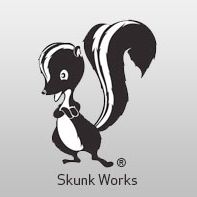Lockheed Skunk Works

Skunk Works consisted of Lockheed’s best design engineers and technicians who occupied a rented circus shelter adjacent to a foul-smelling plastic factory (hence the Skunk Works moniker, inspired by a mysterious moonshine factory in a famous Al Capp comic strip called Li’l Abner.) More significantly, Skunk Works was isolated from corporate bureaucracy, granted much autonomy over decision-making, and encouraged to disregard standard procedures in the interest of expediency. In a record 143 days, Skunk Works designed, developed, and delivered the Lockheed P-80 Shooting Star aircraft, the first jet fighter operated by the United States Army Air Forces.
The Skunk Works framework of innovation was so successful that Lockheed has continued to operate this division for decades. Clarence “Kelly” Johnson, team leader of the first Lockheed Skunk Works project, codified 14 rules for all Skunk Works projects. Over the years, Lockheed’s Skunk Works designed and developed many aircraft, including the famous U-2 reconnaissance plane.
Disentangled from Bureaucracy and Management Constraints
Other companies borrowed this innovation idea from Lockheed to develop advanced products or discover product/service/business ideas that are entirely new to their parent organizations. Many businesses and engineering companies started their own “skunkworks” divisions consisting of self-directing teams of highly talented individuals who were seconded from their regular work environments. Unconstrained by executive interference, they operated under the radar. They were given a high degree of autonomy, access to R&D funds, and exceptional freedom from the parent organization’s bureaucracy and management constraints. Here are some examples of skunkworks projects.
- At IBM, a skunkworks project in 1981 pioneered industry standards to adapt personal computers for business needs and released the IBM PC. This helped IBM break away from its lynchpin mainframe business and launch its celebrated personal computers division. IBM has since continued the skunkworks tradition. In the 2000s, IBM established many “emerging-business opportunities” or EBO teams and assigned its best and brightest people in charge of risky startup ideas that could germinate new business lines in five to seven years.
- At Motorola in the mid-2000s, a team of designers and engineers defied the company’s own rules to develop the best-selling RAZR mobile phone. This skunkworks team was isolated from Motorola’s main R&D facility. Fortune magazine noted that this “tight-knit team repeatedly flouted Motorola’s own rules for developing new products. They kept the project top-secret, even from their colleagues. They used materials and techniques Motorola had never tried before. After contentious internal battles, they threw out accepted models of what a mobile telephone should look and feel like. In short, the team that created the RAZR broke the mold, and in the process rejuvenated the company.”
- Google’s famous 20% rule and innovative workspaces lets employees collaborate across the company and work on their dream projects, but bring those projects to the larger collective for further funding and development. Many of Google’s innovative products and features in Gmail, Google News, Google Talk, Google Suggest, Transit Directions, etc. originated as 20% projects.
- Microsoft’s skunkworks located in Studio B facility on its Redmond campus developed Kinect, Surface tablets and computers, and other recent products.
- Apple has the most celebrated of skunkworks teams. Apple Chief Design Officer Jonathan Ive’s design laboratory consists of a few handpicked designers who work on “very experimental material that the world is not quite ready for.” Working in an area separate from Apple’s main Cupertino campus, Ive’s team maintains a culture of incredible secrecy.
Skunkworks Innovation Model and Startup Cultures
In the 1960s and 1970s, the skunkworks concept fell out of favor, as many companies started to see skunkworks teams as distractions and as cost centers “with an attitude.” However, with a renewed emphasis on teamwork and a focus on setting up startup-like innovative workplaces where teams can flourish, the skunkworks model of innovation has been renewed and revived in the last two decades.
Inertia, internal politics, bureaucracy, layers upon layers of management questioning risk and rewards, and the fear of failure weigh heavily on many a company’s pursuit of new products and services. The skunkworks innovation model and the startup culture offer frameworks for organizations to pursue growth ideas separate from current lines of business.
In 2013, General Electric instituted a program called FastWorks to mimic Silicon Valley’s startup culture in a company-wide effort to foster innovation and develop products quickly and cost-effectively. Boeing’s Phantom Works, Nike’s Innovation Kitchen and Sports Research Lab, Amazon’s Lab126 and A9 laboratories, Google X, and Walmart Labs are some of today’s prominent skunkworks organizations.
Idea for Impact: Autonomy Fosters a Creative Environment
For managers, the key take-away from the skunkworks concept is that giving autonomy to employees and teams not only engenders a happier and satisfied workforce, but also fosters a creative environment. Some ideas to consider:
- Give much autonomy to those employees and teams who have demonstrated the promise of being self-directed and maintaining alignment with the larger organizational goals. Direct them, oversee their progress, and follow-up when necessary. Micromanage when you must.
- Give employees discretion over their tasks and resources. Create a favorable environment in which people are encouraged to discover, use, and grow their unique skills.
- Don’t second-guess employees’ and teams’ ideas and decisions unless necessary. Judging or criticizing not only undermines their confidence, but also keeps them from sharing their ideas with you in the future.
- Allow employees and teams to experiment, iterate their ideas, gather data and develop performance metrics, and quickly discard less promising ideas in favor of stronger ones.
- Support risk-taking and failure. Celebrate failure as it can provide valuable technical and organizational insights. Encourage employees to be confident enough to try to fail and learn lessons without being apprehensive about being rebuked.